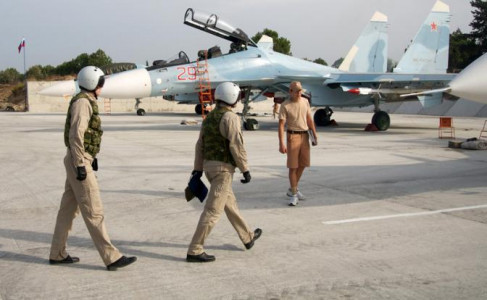Original by Anton Mardasov published by Svobodnaya Pressa; translated from Russian by J.Hawk
Russia is preparing to establish a second airbase in Syria, after Hmeimim. According to The Times and Al-Rai (Kuwait), the new airbase will be the Shairat, 35km southeast of Homs in central Syria.
An additional 50 aircraft are to be deployed there, plus a spetsnaz brigade and support personel. There already are Russian military personnel at Shairat, as well as helicopters and base preparation troops. At the moment the base is being used by Syrian Air Force which bases MiG-23, -25, and Su-22 aircraft there. Moreover, Moscow is about to send a large number of TOS-1 rocket self-propelled armored flamethrowers to Syria.
A Russian defense source told lenta.ru that Shairat is necessary in order to prosecute operations in southern and eastern Syria.
–In order to support the offensive in the vicinity of Palmira and further to the east, toward Deir-es-Zor, Hmeimim is rather too far especially when it comes to using helicopters and attack aircraft which need to be based closer to their targets in order to ensure they are destroyed in a timely manner, said the source. Russian VKS used Shairat on earlier occasions as a forward base.
Russian MOD is not commenting on the reports that the operation will be expanded.
SP already reported earlier that in November there appeared reports on Russia using four bases to launch raids against the militants. In addition to Hmeimim in the Latakia province, helicopter sections were flown to the Tiyas airbase between Homs and Palmira as well as Hama and Shairat bases near Homs.
On November 17, the General Staff during a briefing for President Vladimir Putin displayed a slide showing Syrian air operations against the town of Mkhi. The presentation, which was the subject of a Russia Today report, showed that near Shairat there is a deployed unit of Russian artillery, specifically six Msta-B towed howitzers of the 5th Howitzer Battery of the 120th Guards Artillery brigade.
The former head of the Main Directorate for International Military Cooperation of the Russian Ministry of Defense, Colonel-General Leonid Ivashov says that the time to establish a second airbase in Syria has come.
–The standard scenario is one regiment, one airbase. Our small group in Latakia was the first step. Our permanent presence in Syria demands further infrastructure development and increasing the size of the air group.
It is now necessary to expand Russian presence in Syria in order to increase the number of airstrikes, to deploy additional fighter aircraft in order to provide protection for the strike aircraft, and to base electronic intelligence gathering aircraft to locate targets for aircraft and cruise missiles. I would not rule out the deployment not only of the Il-20M but also the A-50 airborne early warning aircraft. The Military Transport Aviation component will also be increased to ship munitions and other cargoes.
All of these measures are sensible since it’s obvious that the Russian presence in Syria is a long-term affair. It’s also logical to expect the deployment of not only air assets since a new threat has emerged in the form of Turkish army invasion into Syria to create a so-called “buffer zone.” These would not be scattered militant bands but an organized military force. Therefore we will need to deploy something to attack land units in the event the Turks attempt to invade.
SP: Western media write additional forces will be sent to Shairat…–There’s no way around it. If we are to establish a base there, we can’t count on the Syrians to ensure the security of the daily shipments. We’ll have to send columns Afghanistan-style, with a security detachment complete with armored vehicles to sweet the road for explosives or to establish checkpoints.It was one thing when Sharat was being used as a staging base, a forward basing site for army aviation. Then only small forces were required. But if we are to set up a whole new airbase, we’ll need to deploy sizable ground components, greater than what was needed to protect and defend Hmeimim which is close to the coast.That’s the whole problem. But I don’t see any problems with seaborne supply for the whole force. The Montreaux Convention is an international treaty and Turkey cannot unilaterally stop our ships and warships.
SP: Media report that Shairat is needed to support operations in southern and eastern Syria…
–That’s still some ways off. We still haven’t eliminated the militant enclave between Hama and Homs in western Syria, the offensive in the north is not going especially well. These are the key operational directions. Attacking in the east means attacking along roads in a relatively narrow channel. There are no particularly important sites there on which the existence of Syria’s army and the state as a whole depends.
In principle, it’s enough to limit oneself to the Damascus-Deraa and Homs-Hama highways.Once the west is clear of the militants, it will be a huge success. It will allow the Syrian state to exist for a long time. Therefore attacking Palmira, Deir-es-Zor, Raqqah are secondary tasks.
J.Hawk’s Comment: There is one extra factor to consider, namely the sudden activization of Western military activity over eastern parts of Syria which are held by the ISIS. It would appear that the West might not be wholly willing to succumb to the combined Syrian and Iraqi efforts, with Russian support, and might make a bid to introduce a “stabilizing” force of its own that would preserve “rebranded” and renamed ISIS in existence so as to ensure there exists a Sunni “corridor” separating Shia Iraq and Iran from Syria and Lebanon. Since overthrowing Assad is out of the question, this might be the West’s Plan B. Which in turn might require a military push eastward while temporarily containing militant enclaves in western Syria.






